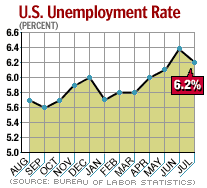NEW YORK (CNN/Money) -
U.S. employers cut thousands of jobs in July, the government said Friday, defying expectations that payrolls would grow, but a decline in the labor force sent the unemployment rate down.
The jobless rate fell to 6.2 percent from 6.4 percent in June, the Labor Department said. Economists, on average, expected the rate to fall to 6.3 percent, according to a Reuters poll.
But non-farm payrolls fell by 44,000 jobs, the report said, after losing a revised 72,000 jobs in June. Economists, on average, expected payrolls to grow by 18,000 jobs, according to Reuters.

The two numbers moved in opposite directions because they are generated by separate surveys, and the unemployment rate fell mostly because the size of the labor force -- the number of working-age people either working or looking for work -- shrank by 556,000 people in July.
"This is a pretty negative report. The reason unemployment ticked down is the labor force contracted," Jared Bernstein, labor economist at the Economic Policy Institute, a Washington think tank, told CNNfn. "That suggests fewer people are getting into the game, looking for work, and that kind of discouragement can lead to a lower unemployment rate."
| 
| |

| 
| 
|

|
 The unemploy-ment rate fell to 6.2 percent in July from 6.4 percent in June. CNNfn's Lisa Sylvester reports. The unemploy-ment rate fell to 6.2 percent in July from 6.4 percent in June. CNNfn's Lisa Sylvester reports.
|
|
 Play video
Play video
(Real or Windows Media)
|
| 
|

|
|
Nine million people were unemployed in July, compared with 9.4 million in June. Two million have been out of work 27 weeks or more.
U.S. stock prices fell in early trading. Treasury bond prices reversed earlier losses on signs of weakness and low inflation in a report on the nation's manufacturing sector.
In Friday's jobs report, payrolls in goods-producing industries fell 67,000 in July, including 71,000 jobs cut from the manufacturing sector.
Makers of computer and electronic products cut about 11,000 jobs in July -- employment in that sector has fallen every month since January 2001.
Service-producing payrolls grew by 23,000, despite the loss of 14,000 retailing jobs. Businesses added 42,000 temporary workers to payrolls in July. A rise in temp hiring could be a sign businesses are increasing activity and preparing to make permanent hires.
"The total rise in temp jobs in the past three months, 122,000, is the biggest since the data began in 1990," said Ian Shepherdson, chief U.S. economist at High Frequency Economics Ltd. "Usually, big swings in temp jobs lead overall employment by a few months, so this is a powerful positive signal."
But the average workweek shrank to 33.6 hours from 33.7 in June, indicating businesses pulled back activity in July. Manufacturing hours shrank to 40.1 from 40.3 in June.
And Anthony Chan, chief economist at Banc One Investment Advisors, in a discussion with Labor Secretary Elaine Chao on CNNfn, pointed out that many of the new temp workers could be filling in for reservists called to duty in the war with Iraq.
| 
| |

| 
| 
|

|
 Labor Secretary Elaine Chao comments on the latest unemployment numbers and the economy. Labor Secretary Elaine Chao comments on the latest unemployment numbers and the economy.
|
|
 Play video
Play video
(Real or Windows Media)
|
| 
|

|
|
Chao replied that reservist call-ups had contributed to the drop in the labor force and said some of the negative numbers in the report may have been due to seasonal factors. For example, she said, many women stay home to watch their kids in the summer, which may have contributed to the drop in the labor force.
"Given the rest of the economic news, including the fact that GDP growth is positive, inflation is still low, jobless claims are still moving downward and temporary services are firming up, that means the recovery continues, and we hope it will continue in a more robust fashion," Chao said.
Average hourly wages rose 5 cents, or 0.3 percent, to $15.44 an hour from a revised $15.39 in June. In a weak labor market, wage growth is a critical support to consumer spending, which makes up more than two-thirds of the nation's economy.

|

